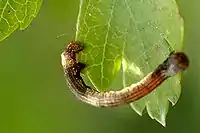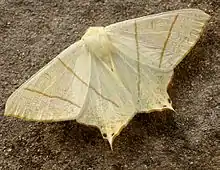Swallow-tailed moth
The swallow-tailed moth (Ourapteryx sambucaria) is a moth of the family Geometridae. The species was first described by Carl Linnaeus in his 1758 10th edition of Systema Naturae. It is a common species across Europe and the Near East.



| Swallow-tailed moth | |
|---|---|
 | |
| Scientific classification | |
| Kingdom: | Animalia |
| Phylum: | Arthropoda |
| Class: | Insecta |
| Order: | Lepidoptera |
| Family: | Geometridae |
| Genus: | Ourapteryx |
| Species: | O. sambucaria |
| Binomial name | |
| Ourapteryx sambucaria | |
| Synonyms | |
| |
Description
This is a large (wingspan 50–62 mm), impressive moth, remarkably butterfly-like. All parts of the adult are bright white to pale yellow marked with faint buffish fascia. The species gets its common name from pointed projections on the termen of the hindwing with brownish spots at their base. It flies at night in June and July and is attracted to light, sometimes in large numbers.
The brown, twig-like larva feeds on a variety of trees and shrubs including elder, hawthorn, honeysuckle and ivy. The species overwinters as a larva.
- ^ The flight season refers to the British Isles. This may vary in other parts of the range.
References
- Chinery, Michael Collins Guide to the Insects of Britain and Western Europe 1986 (Reprinted 1991)
- Skinner, Bernard Colour Identification Guide to Moths of the British Isles 1984